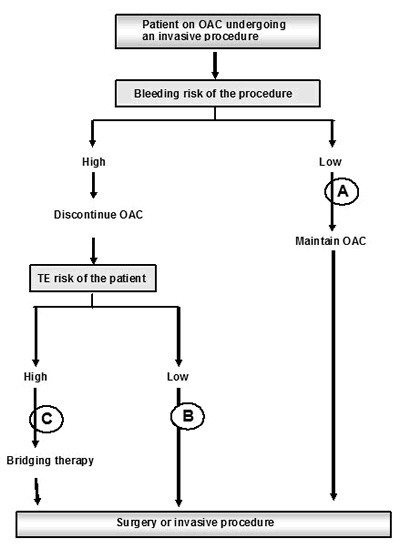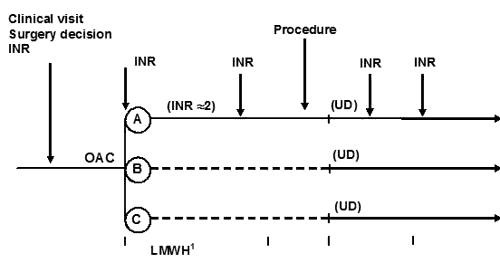I - KEY FEATURES
• Many diagnostic and surgical procedures carry a low bleeding risk and should be performed without discontinuing oral anticoagulant therapy (OAC). The only precautionary measureto take would be to check that International Normalised Ratio (INR) does not exceed the prescribed upper limit or even is set slightly under range (a value of 1.5 to 2.0 is safe in the majority of cases).
• OAC must be discontinued in patients with low thromboembolic risk a few days before the procedure if the inherent bleeding risk of that procedure is relevant. These patients do not need any bridging antithrombotic therapy neither before nor during the procedure, with the exception for that required by the intervention itself.
• Finally, if bleeeding and thromboembolic risks are both relevant, OAC must be withdrawn and prophylactic “bridging” therapy provided; this therapy may be prescribed as an outpatient basis following a defined protocol. Hospital admission for specialized haematologic care before the procedure is only indicated for patients with severe thrombophilic disorders or complex diseases.
II - BACKGROUND
The clinical dilemma
Patients under chronic oral anticoagulant therapy (OAC) have been increasing in number and complexity over the years(1). For that reason, clinicians are frequently facing this dilemma: an anticoagulated patient has to undergo surgery or an invasive diagnostic or therapeutic procedure. Three alternatives related to anticoagulation can be considered: a) to discontinue OAC, carrying with the risk of thromboembolic events; b) to perform the procedure under OAC, facing the chances of increased bleeding; o c) to substitute OAC by another antithrombotic therapy (“bridging therapy”) before and during the procedure, counterbalancing the aim of shortening as much as possible the unprotected period against thromboembolic events and the likely increase in bleeding complications(2).
The problem gets worse because of the lack of specific studies -most of them observational- and the shortage of clear guidelines, not unanimous neither(2-8). So, in most cases doctors have to weigh up individually the balance between risks and benefits of the chosen alternative. An easy -although inadequate- solution of this dilemma for the clinician responsible for the patient would be to wash his/her hands of the problem and transfer it to the anesthesiologist, the surgeon, or the doctor-in-charge of the procedure. The best attitude is to decide the therapeutic approach in accordance with those mentioned specialists, to explain to the patient and relatives the aims, grounds, steps, and likely risks of the proposed plan, and to implement it before and after the procedure.
Risk/benefit ratio of anticoagulant treatment
Bleeding risk caused by OAC during surgery or instrumental procedures is related directly to the dose of the former and its proximity to the latter(1); bleeding risk inherent to the procedure itself must be added as well.
With regard to parenteral anticoagulants to prevent thrombosis, subcutaneous low molecular weight heparins (LMWH) or intravenous unfractionated heparin (UFH) at low doses have demostrated good preventive efficacy against venous thromboembolic events; however, to prevent arterial thromboembolic events higher doses are required(1,2,4).
The basis for the decision
The first decision should be based on the risk of bleeding inherent to the planned surgical or diagnostic procedure. That risk is divided into low or high according to some characteristics of the procedure itself and those of the patient. Table 1 lists some of the frequently performed procedures with high risk of bleeding(2). In the low-risk category, among some other, can be included dermatologic, dental (perhaps with the exception of wisdom tooth extraction), ophthalmologic, and arthroscopic interventions. Evidence supports that significant bleeding complications are very unusual in those procedures in which blood loss is scarce or it is easy to control by local haemostatic measures9,10. Therefore, these procedures can be performed safely on OAC at full doses, provided INR is below 3.0. Anyway, clinicians frequently try (largely by empirical reasons) to set this value slightly under the lower limit of the usual therapeutic interval (rounding 1.5 to 2.0 commonly).
The second decision lies on deciding in which patients anticoagulant treatment needs to be necessarily maintained, because of their high thromboembolic risk (Table 2) and which of them have a low risk of thromboembolic events even if that treatment is temporarily discontinued. The three main indications of OAC are valve prosthesis, atrial fibrillation and venous thromboembolic disease(11,12). Patients with mechanical valves always are at a high thromboembolic risk and need bridging treatment if OAC needs to be discontinuated before operation. Good evidence on the real efficacy of UFH or LMWH is scarce in this context. The same applies to patients with high-risk atrial fibrillation (CHADS2 score > 2)(13), because some data suggest that thromboembolic risk during perioperative period is only slightly reduced with bridging therapy compared to simply stopping OAC for a short period. In patients with low-risk atrial fibrillation some studies have demonstrated the low incidence of thromboembolic events after withdrawal of OAC. Mostly by subjective reasons as well, many doctors try to keep at minimum the period of time in which patients are undercoagulated. Patients with venous thromboembolic disease may be managed with UFH or LMWH at prophylactic doses, as in other circumstances in which these drugs are used to prevent embolic events during surgery.
If both thromboembolic and bleeding risks are significant, OAC should be discontinued and at the same time prevention against thromboembolic events should be assured. There are no clear guidelines for recognizing those patients, but it can be assumed that correspond roughly to those not included in the two preceding categories; we also lack of a thorough evaluation of risk-benefit ratio of bridging therapies and which of them is better. Alternatives are intravenous UFH or subcutaneous LMWH. Despite many disagreements, guidelines prefer LMWH due to their easier use(11).
III - PRACTICAL GUIDELINES
Figure 1 summarizes the general approach for patients in whom surgery or an invasive procedure is planned and are under chronic OAC. The specific components of implementation of that approach are as follows (figure 2):
• Any anticoagulated patient undergoing an invasive procedure or surgery should be evaluated beforehand to decide appropriate treatment and to determine blood and coagulation parameters (INR).
• If bleeding risk of the procedure is low (pathway A in figure 2) OAC should go on (provided INR is below 3.0), with just a slight reduction of dose a few days before (5 days for warfarin; 3 days for acenocumarol). Usual dose is resumed after the first day of the intervention if uneventful.
• If the procedure carries a significant bleeding risk and thromboembolic risk is not high (pathway B in figure 2), OAC should be discontinued before the procedure (5 days for warfarin; 3 days for acenocumarol) and restarted after the first day. No bridging treatment is necessary; in some cases the use of LMWH at prophylactic doses may be considered, depending of the thrombotic risk of the patient or the procedure.
• For patients with a high thromboembolic risk (valve prosthesis, previous thromboembolic event, any medical condition carrying a high thromboembolic risk or surgery with a high risk of venous thromboembolic complication) (pathway C in figure 2), OAC should be discontinued before the procedure (5 days for warfarin; 3 days for acenocumarol) and substituted by a LMWH at full dose. This drug in its turn is withdrawn 12-24 hours before the procedure and restarted 12 hours after, overlapped with the reinitiation of OAC until INR reaches a value > 2.0.
Table 1: Some procedures with a high risk of bleeding (included but not limited to)
Extracorporeal surgery
Intracraneal and spinal cord surgery
Abdominal aneurysm resection
Major peripheral vascular surgery
Extensive cancer surgery (neural, urogenital, cervical, abdominal, breast)
Major orthopaedic surgery (hip and knee replacement, laminectomy)
Extensive reconstructive plastic surgery
Transuretral resection and bladder interventions
Solid organ biopsy
Intestinal polipectomy
Table 2 : Some clinical scenarios with a high thromboembolic risk
Previous venous thromboembolic event (< 3 months)
Atrial fibrillation with previous embolic event
Mechanical cardiac prosthesis
Thrombophilic disease (congenital or acquired)
Acute myocardial infarction (< 3 months)
Ischaemic stroke (< 1 month)
Figure 1: General management of oral anticoagulant therapy in patients undergoing an invasive procedure (A, B, and C refer to the three distinct pathways and protocols detailed in figure 2).
OAC: oral anticoagulant treatment; TE: thromboembolic.

Figure 2: Pathways and protocols for anticoagulated patients undergoing invasive procedures
(A, B, and C pathways correspond to those pointed out in figure 1).
1 Enoxaparin 1 mg/kg/12 h or Tinzaparin 175 U/kg/24 h
2 Referred to acenocumarol. Figures between brackets correspond to warfarin
INR: international normalized ratio; LMWH: low molecular weight heparin; OAC: oral anticoagulant treatment; Procedure: day of surgery or procedure; UD: usual dose.
continuous line = treatment active
dotted line = treatment withdrawn




 Our mission: To reduce the burden of cardiovascular disease.
Our mission: To reduce the burden of cardiovascular disease.